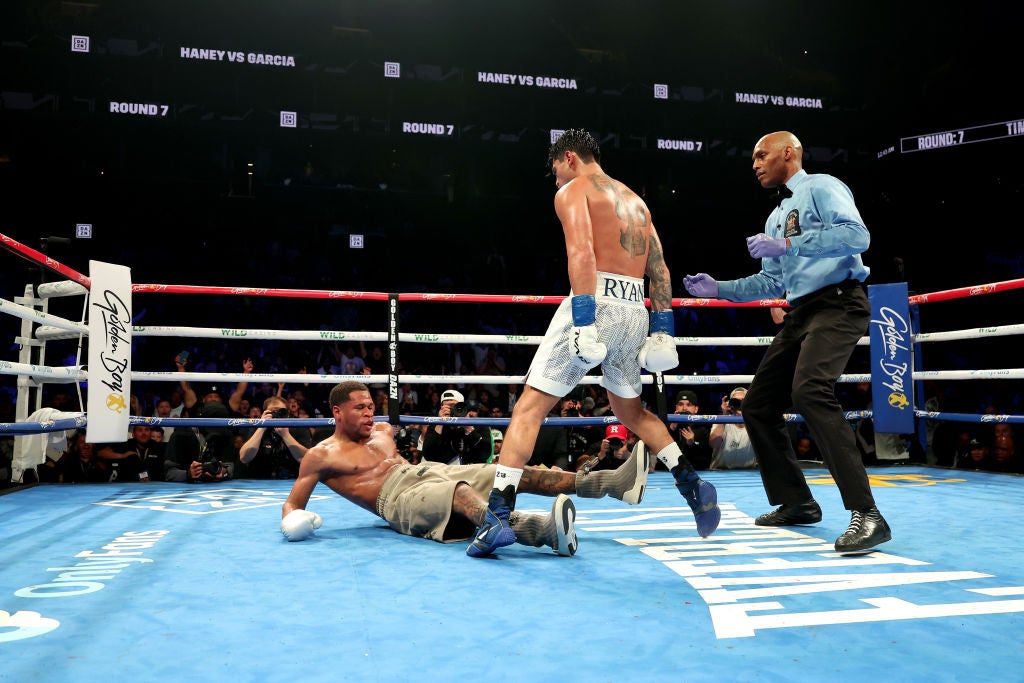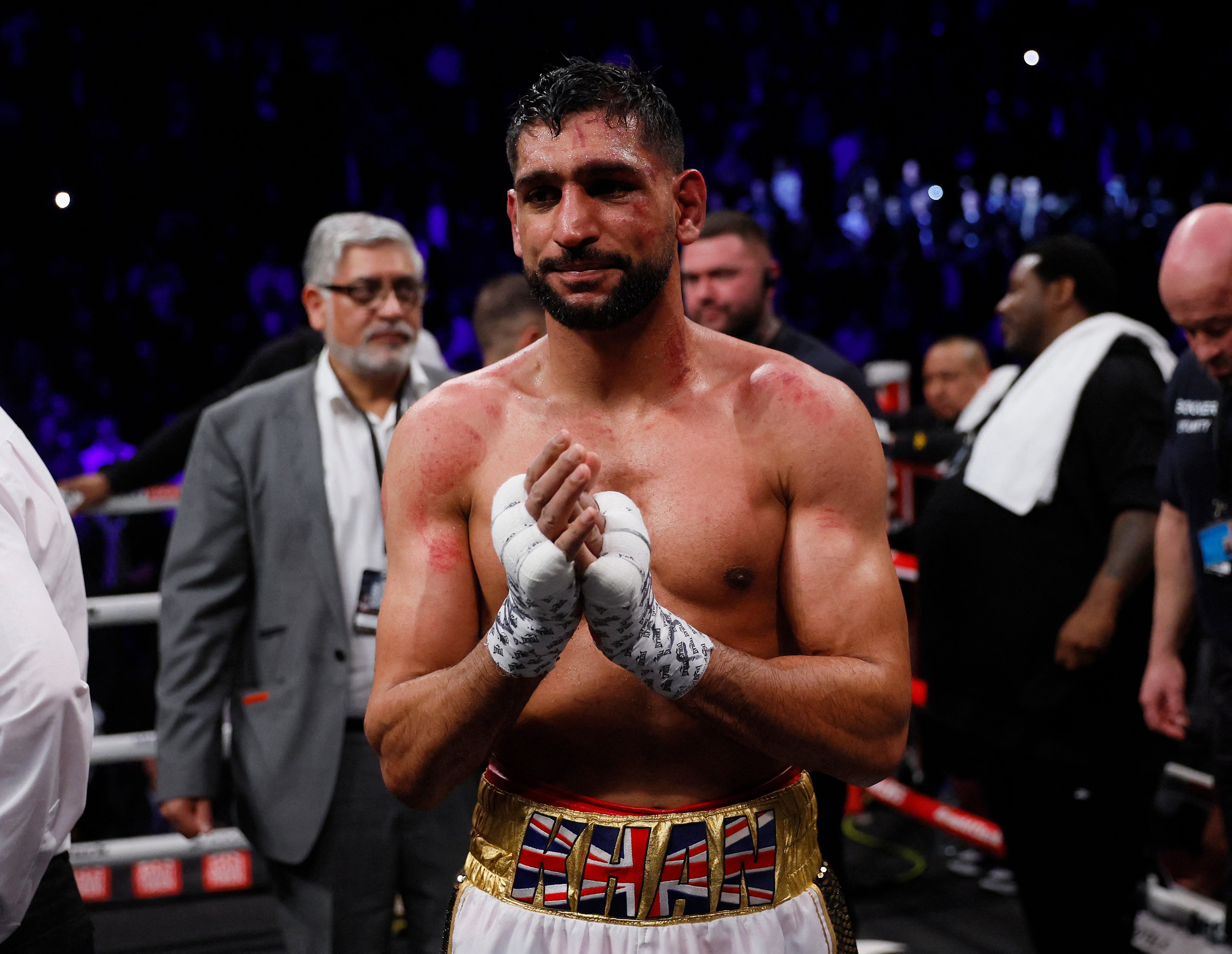Ryan Garcia: Everything we know so far as drug-test saga continues
Amid reports that the 25-year-old has tested negative for a nandrolone metabolite, here is a timeline of the boxing controversy
In the latest development in Ryan Garcia’s ongoing drug-test saga, the boxer has reportedly tested negative for a nandrolone metabolite.
But what does this news mean, and how did Garcia get here?
Below, Indy Sport breaks down the timeline of this controversy.
19 April: Garcia misses weight for title fight with Devin Haney
One day before Garcia’s fight with Haney for the WBC super-lightweight title, the challenger missed weight by 3.2lbs. Garcia, 25, claimed that he had done so intentionally to improve his chances of beating Haney, also 25. Garcia’s failed weigh-in made him ineligible to win the title, however.
This controversy followed a spell of concerning online behaviour from Garcia, which ranged from the outlandish – such as vouching for the existence of aliens – to the far more serious, alleging that he suffered sexual abuse as a child and claiming to have witnessed human trafficking.
As a result, Garcia underwent a mental-health evaluation before fighting fellow American Haney.
20 April: Garcia achieves shock win after scoring three knockdowns
In a verified upset, Garcia floored the previously unbeaten Haney three times en route to a majority-decision win at the Barclays Center.
After the fight, Garcia claimed his pre-fight behaviour had been an “act”, with the exception of his drinking; he claimed he had been consuming alcohol frequently throughout his fight camp.
1 May: Reports emerge that Garcia has failed drug tests

On 1 May, it was reported that Garcia failed two drug tests on the week of his win over Haney, testing positive for the banned substance Ostarine on 19 April and in the hours after the fight. Garcia denied ever using steroids. These reports were first published by boxing journalist Dan Rafael and ESPN.
As is typical, the B-samples from Garcia’s tests – which were conducted by the Voluntary Anti-Doping Association (Vada) – have required more time to be tested and have not yet been released. Usually, B-samples confirm the result of the A-samples. One of Garcia’s tests reportedly screened for a nandrolone metabolite: 19-Norandrosterone. All of Garcia’s previous tests had come back negative.
Garcia reacted to the reports by tweeting: “Everybody knows that I don’t cheat. Never taken a steroid, I don’t even know where to get steroids. I barely take supplements. Big lies.”
Haney said: “It’s unfortunate Ryan cheated and disrespected both the fans and the sport of boxing by fighting dirty and breaking positive not once, but twice. Ryan owes the fans an apology, and by his recent tweet, he still thinks this is a joke. We put our lives on the line to entertain people for a living. You don’t play boxing. This puts the fight in a completely different light. Despite the disadvantage, I still fought on my shield and got back up! People die in this sport. This isn’t a joking matter.”
Garcia’s promoter Golden Boy, run by boxing legend Oscar De La Hoya, said: “Ryan has put out multiple statements denying knowingly using any banned substances – and we believe him.”
What is Ostarine and who else has tested positive for it?

Ostarine, a selective androgen receptor modulator (Sarm), is used to increase muscle growth. Specifically, Sarms can improve lean body mass by helping to regulate body fat.
In April 2023, it was revealed that ex-champion Amir Khan had tested positive for Ostarine on the night of his loss to Kell Brook in February 2022. Khan, who was stopped by his fellow Briton and later announced his retirement, was handed a two-year backdated ban.
Khan, who was cleared by UK Anti-Doping of intentional ingestion, said in April 2023: “I’ve never cheated. I’m a retired fighter, and at the same time, you can see by my performance; my performance against Kell Brook wasn’t the best performance that I had. I lost the fight; if I went in there and knocked Kell Brook out, it’d be different.”
UFC bantamweight champion Sean O’Malley also tested positive for Ostarine, in 2019. United States Anti-Doping cleared the American of intentional consumption and handed him a six-month ban.
8 May: Garcia is reportedly negative for nandrolone metabolite
It was reported on 8 May that the tests which screened for 19-Norandrosterone came negative for that metabolite. The Independent has contacted Vada for comment.
Garcia took to X to address the news, while claiming that the amount of Ostarine in his system could not have been performance-enhancing. “A billionth of gram [of Ostarine] found in my system bruh you can’t make this up,” he wrote. “Everyone backtracking now. STOP MESSING WITH ME. DEFAMATION LAWSUITS. all you fake ass reporters.”
Meanwhile, ESPN’s Mike Coppinger tweeted: “Ryan Garcia’s attorney, Darin Chavez, told ESPN on Tuesday that the B-sample will be opened and analyzed May 22. Chavez will witness the examination. Ostarine is the substance that was present in his A-sample. Chavez said yesterday’s VADA report showed 19-Norandrosterone wasn’t present in Garcia’s system.
“Chavez claimed this is proof ‘we are dealing only with a known supplement contaminant in the billionth of a gram range that provided Ryan Garcia with no performance-enhancing benefit whatsoever on fight night. We now wait for B-sample testing on the presence of low-level Ostarine only on May 22.’”
Is there any truth to Garcia’s claims?

Ostarine and 19-Norandrosterone both appear on Vada’s prohibited list, and that of the World Anti-Doping Agency. There are no references on Vada’s list to a specific ‘limit’, ‘amount’, or ‘level’ of either substance.
In other words, as Dan Rafael tweeted on 8 May: “NO amount of Ostarine is allowed in the system. It’s not a threshold drug where [a] certain level [is] allowable (i.e. clenbuterol, testosterone, etc) but over [a] certain level is [a] failed test. Ostarine a failed test at ANY level. How it got there isn’t relavent [sic]. It’s that it’s there. Period.”
Garcia’s tweet also led renowned sports nutritionist Victor Conte to write: “FAKE NEWS is being spewed about NYSAC [New York State Athletic Commission]’s chart of allowable limits for PEDs [performance-enhancing drugs]. Ostarine has a .1 ng/ml allowable limit & @RyanGarcia had 6 ng/ml reported for 4/19 which is 60 TIMES over the limit. History of B sample testing is 99% confirmation of A.”
Replying to one user who questioned what amount of Ostarine would be performance-enhancing, Mike Coppinger noted: “You can still have low levels if you are cycling off or micro-dosing.”
Ostarine and 19-Norandrosterone both come under the ‘anabolic agents’ section of Vada’s list of prohibited substances, after the note: “The following classification groups and substances are prohibited at all times during participation in the Vada program.
“The following classification groups and substances listed herein are not restricted to the specifically-listed common or chemical names, nor are they restricted to the specific compounds or isomers listed below. Moreover, VADA has the right, at any time, to modify, edit, and add any substance or method according to any new laws, guidelines, VADA policies, or anti-doping ideals.”
What comes next?

On 22 May, Garcia’s B-samples are set to be revealed, potentially confirming the positive results of his A-samples. Per past cases, including those of Amir Khan and Sean O’Malley, Garcia could be set for a ban of up to two years – even if he is cleared of intentional doping.
On 8 May, Garcia called out fellow American Errol Spence Jr on X. Spence, a former unified welterweight champion, last fought in July, losing his undisputed title fight against Terence Crawford. That stoppage loss marked the first pro defeat of Spence’s career.
Spence, 34, responded to Garcia by tweeting: “I’ll legit beat his ass (at the at&t stadium at 154-160[lbs]) off the strength of him testing positive but [I don’t] take tune ups.
Referencing Garcia’s sole pro loss, a body-shot stoppage by Gervonta Davis in April 2023, Spence added: “Stop letting this boy get a pass like we don’t remember you taking a knee & getting up at 10 .. coward as f***.”



Join our commenting forum
Join thought-provoking conversations, follow other Independent readers and see their replies
Comments